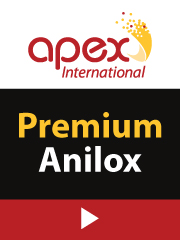FTA winners show off strides in Flexo
- Published: July 01, 1996, By Walker, Juliana M.
The Flexographic Technical Assn. competition finds 106 entries worthy of honors, proving that flexo has come a long way.
The Flexographic Technical Assn. handed out its 1996 Excellence in Flexography Awards to 106 winning entries at the FTA's Annual Forum in Boston, MA, held May 13-15.
Entry classifications included wide web, narrow web, combined corrugated, preprinted linerboard, envelopes, newspaper/publications, student entry, and special achievement. Entries were judged on two general standards: degree of difficulty (printability/ink compatibility, registration tolerances, plate multiformity, fineness of print/screen, tonal range, converting complexity, and defect visibility); and level of execution (image sharpness, ink coverage, registration, dot/screen/vignette quality, and consistency).
Judging the competition were Dave Akin, Menasha Corp.; Randy Bittinger, McCourt Label Co.; Vincent Blyden, Florida A&M Univ.; Darrell Dochstader, Gar-Doc Inc.; Edward Herter, Flexi Printing Plate Co.; Jean Jackson, Praxair Surface Technologies; John Kienzle, Propheteer Line; Daryl Leeson, Spectrum Label Corp.; R. Phillip Le Juene, Werthan Packaging Inc.; Gene Mallows, Privateer Ltd.; Gene Martin, Robinette Co.; Doug Nelson, Werneke & Mulheran Inc.; William O'Haver, E.I. du Pont de Nemours & Co.; David Recchia, Polyfibron Technologies; Dave Root, Georgia-Pacific Corp.; Glenn Sanders, Stone Container; Robert Smithson, Trinity Graphic USA; Bruce Underwood, Teepak Inc.; and Ronald Weinberg, Harper Corp. of America. Also acting as judges were Awards Committee members Dale Bunnell, Mark Andy Inc.; Howard Vreeland Jr., Anderson and Vreeland Inc.; and Tony Bart, DuPont.
A rules change allowed printers to submit no more than three entries per subcategory, but they could enter as many subcategories as they wished.
Judges were definitely impressed with what they saw. According to William O'Haver, "As a general rule, the quality level is better than ever, enabling the flexographer to capture work from competitive processes. Each area of technology - aniloxes, inks, plates, etc. - is pushing ahead. Tonal range capability is expanding; high-solids inks are improving densities; direct-to-plate technology is becoming a reality for photopolymer - all reflect flexo's growth into a measurable, predictable, high quality process second to none."
The most noticeable improvement, reports FTA, was in corrugated. "This segment is taking advantage of the technological advances - such as laser-engraved ceramic anilox rolls and doctor blade inking systems - that have become almost standard in other areas of the industry," says Ed Herter. "Several years ago corrugated converters would never have reached this quality level. The progress is evident," adds Glenn Sanders.
Following are details (including comments from the entrants) of the first-award winners that were selected Best of Show. They serve as outstanding examples of today's achievements in flexography.
Wide web, paper, screen
Winner: 20# Pro Pet Puppy Food, submitted by Agway Inc. d/b/a Apex Bag Co.
Press: stack
Plates: photopolymer
Plate thickness: 0.107
Inking system: two roll and doctor blade
Mounting system: optical
Inks: water
Sequence of printing: 1788 red (250), warm grey (500), black (400), black (400), 246 purple (180), black (250)
Hours run: 4.75
Press speed: 235 fpm
Screen count: 100
Comments: Excellent results were achieved with conventional processes because of attention to details.
Narrow web, paper, process
Winner: Perennial Mix, Wild Flowers, submitted by Rotocolor Inc.
Art techniques: electronic
Press: in-line
Plates: photopolymer
Plate thickness: 0.067
Inking system: doctor blade
Mounting system: optical
Inks: water and ultraviolet
Sequence of printing: pink (300), yellow (550), magenta (700), cyan (700), black (700), spot black (360), spot gold (300), varnish UV (200)
Hours run: 4
Press speed: 175 fpm
Screen count: 200
Comments: Features excellent color and grey balance, minimum dot size held in highlight, and minimum dot gain achieved. Also: litho quality reproduction with excellent solid coverage.
Preprinted linerboard, screen
Winner: Black & Decker Blower, submitted by SCI.
Art techniques: electronic
Press: central impression
Plates: photopolymer
Plate thickness: 0.04
Inking system: doctor blade
Mounting system: optical
Inks: water
Sequence of printing: ceramic-line black (330), teal (450), process black (450), process orange (550), line orange (300), varnish (165)
Hours run: 8.5
Press speed: 700 fpm
Screen count: 100
Comments: Combination plate, tight register, and a litho target made the job challenging. One combination plate was teal with a tight register of [+ or -] 1/64 in. The target for the overall appearance was litho carton. Press target was a chromalin.
Combined corrugated, coated, process
Winner: Power Pal, submitted by Lewisburg Container Co.
Art techniques: electronic
Plates: photopolymer
Plate thickness: 0.112
Inking system: two roll and doctor blade
Mounting system: optical
Inks: water
Sequence of printing: all ceramic laser - process black (500), cyan (500), magenta (500), yellow (500), black (300), red (250), varnish (300)
Hours run: 1
Press speed: 5,000 sheets/hr.
Screen count: 110
Comments: This sample is B-flute but still required good solids, good half-tone dots with minimal fluting, and very tight registration, especially the way the four-color area is designed with nothing but a white paper background.













